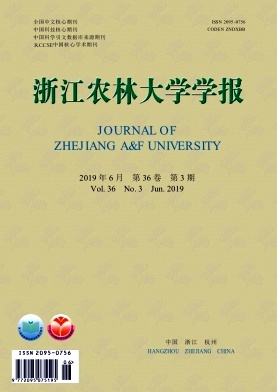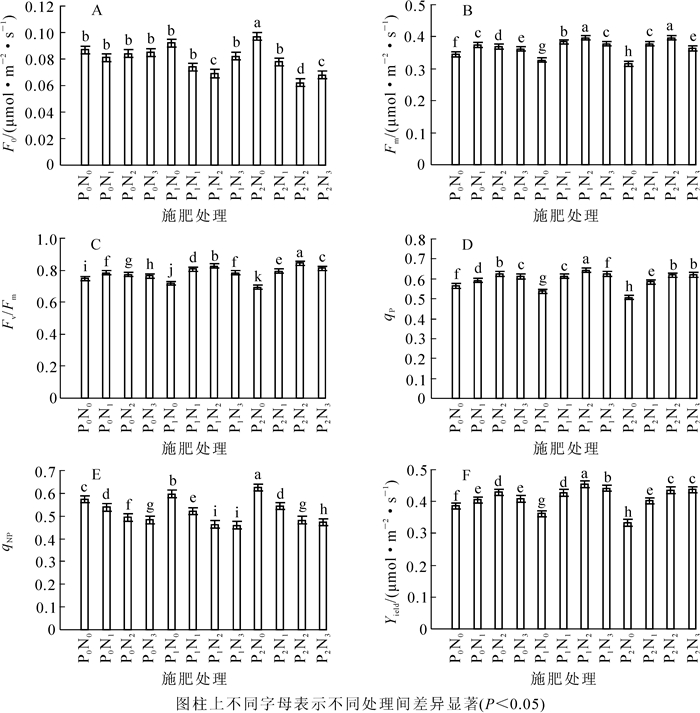-
氮和磷是限制生态系统中植物生长的关键养分因子,对植物的生长有重要的作用,影响着生态系统的生产力和生态过程[1-2]。在自然生态系统中,植物的生长一般表现为氮限制、磷限制或者氮磷共同限制[3]。荣戗戗等[4]研究表明:植物体内氮磷及其比例能充分反映土壤养分供应与植物养分需求的动态平衡,可表征土壤氮素或磷素对植物生长的限制。氮磷添加可调节土壤养分转化[5],提高植物的净初级生产力[6-7],但长期、连续、过量的氮磷输入会降低植物的净光合速率和净初级生产力[8-9]。植物通常会对自身资源进行配置、补偿和平衡,以最大限度减小环境变化对自身的不利影响。因此,探索植物与环境之间的关系,研究土壤-植物相互作用及碳、氮、磷循环,一直都是生态学的研究重点[10]。作为植物对环境变化最敏感的器官,叶片的功能性状能快速、准确地反映植物对环境变化的响应与适应机制[11-12],是当前研究生态系统响应环境变化的重要方法和依据[13]。考来木Correa carmen为芸香科Rutaceae考来木属Correa的常绿灌木,其株型密集,花朵繁多,花型奇特、芳香且多彩、花期长,具有较高的园林观赏价值,被誉为“冬之精灵”[14]。因此,考来木作为珍稀的冬花类园林植物,在冬季少花的华中、华北地区被迅速推广,市场占有量与日俱增。科学的养分管理是提高幼苗生产力和城市园林生态系统功能的主要措施,但目前,有关考来木对肥料添加的生理响应研究尚无报道,现有的研究成果主要集中在快速繁殖[15]和耐高温干旱[16]等逆境生理方面。鉴于此,研究了12种土壤氮磷添加比例对考来木叶片营养含量、光合生理指标和叶绿素荧光参数的影响,分析了叶片功能性状与土壤氮磷化学计量特征的关系,以期为考来木的栽培管理和养分调控等提供科学依据。
HTML
-
2年生红花考来木幼苗,栽于白色塑料盆中,1株·盆-1。花盆规格为12 cm(高)×12 cm(上口径)×9 cm(底径),装干土质量0.6 kg·盆-1。盆土取自平顶山市新城区白龟山下0~20 cm的表层土,黄棕壤,有机质质量分数为21.2 g·kg-1,速效氮质量分数为97.9 mg·kg-1,速效磷质量分数为16.3 mg·kg-1,速效钾质量分数为79.2 mg·kg-1,pH 8.18。
氮肥采用川化集团有限责任公司生产硝酸铵(NH4NO3),氮质量分数≥15%;磷肥采用北京康普汇维科技有限公司生产的磷酸二氢钠(NaH2PO4·2H2O),为化学纯(98%)。
试验用水为平顶山市自来水公司提供的自来水,经四川优普超纯科技有限公司生产的UPT-II-20T UPT超纯水机进行超纯过滤后直接使用或储存备用。
-
采用盆栽控制实验法。将取回的土样置于温室试验区的水泥地面上风干,粉碎后均匀地掺入硫酸钾(K2SO4)和硫酸亚铁(FeSO4),以降低pH值并补充钾肥,K2SO4掺入量(按纯钾计)为75 mg·kg-1,FeSO4掺入量(按商品量计)为70 mg·kg-1,土壤pH值调为7.0~7.5。将土样分成3堆,添加不同数量的磷肥:P0,不添加磷肥,试验中作为对照处理;P1,添加磷肥(按磷酸根计)为36.3 mg·kg-1(干土);P2,添加磷肥为56.3 mg·kg-1(干土)。充分掺拌均匀,备用。将P0,P1,P2分别分成4堆,共12堆。每堆添加相应数量的氮肥:N0,不添加氮肥;N1,添加氮肥(按纯氮计)为197.9 mg·kg-1;N2,添加氮肥为247.9 mg·kg-1;N3,添加氮肥为297.9 mg·kg-1。12堆即为12个施肥处理,分别编号为P0N0,P0N1,P0N2,P0N3,P1N0,P1N1,P1N2,P1N3,P2N0,P2N1,P2N2,P2N3。
-
于2016年2月24日,将配制好的土样装入花盆,同时栽入考来木幼苗。各堆土样分3批装盆,3盆·批-1。将同批装的36盆作为1组,3批即3次重复,共108盆。幼苗上盆后浇透水,置于智能温室中生长。
-
土壤速效氮采用扩散吸收法测定。土壤速效磷采用钼锑抗混合液分光光度法测定。
-
分别于2016年3月20日,6月20日,9月20日,采摘考来木枝条上的健康功能叶,保湿蔽光处理并立即带回实验室,用去离子水清洗干净后,留少许进行叶绿素质量分数测定。其余在烘箱中80 ℃烘干至恒量,取出冷却,粉碎,过0.25 mm筛,备用。叶片全氮质量分数采用张薇等[17]的凯氏定氮法测定。叶片全磷质量分数采用钼锑抗吸光光度法测定。叶绿素质量分数采用孙俊宝等[18]的方法测定。
-
(1)光合生理指标的测定。选择考来木枝条中部健康功能叶,采用美国CIRAS-3便携式光合作用测定系统测定其净光合速率(Pn,μmol·m-2·s-1),气孔导度(Gs,mol·m-2·s-1),胞间二氧化碳摩尔分数(Ci,μmol·mol-1),蒸腾速率(Tr,mmol·m-2·s-1),光合有效辐射(PAR,μmol·m-2·s-1)。每株测定3枚叶片,取其平均值。光合测定时,将仪器连接好后按“on”开机,按“F2”进入设置界面,设置叶室窗口为长方形,18 mm × 25 mm;光源为LED,红光,光强为100 μmol·m-2·s-1;控制参比二氧化碳摩尔分数为390 μmol·mol-1;控制参比空气湿度为80%~100%。(2)叶绿素荧光参数的测定。利用德国WALz公司的Imaging PAM-2500调制式叶绿素荧光仪,按照付为国等[19]的方法测定。
-
数据的初步统计与整理、作图等由Excel完成,数据变异度的方差分析和最小显著差数法(LSD)多重比较由SPSS 23.0完成。
1.1. 供试材料
1.2. 实验设计
1.2.1. 施肥处理
1.2.2. 试验分组
1.3. 指标测定及方法
1.3.1. 土壤速效氮磷质量分数
1.3.2. 叶片氮磷质量分数及叶绿素质量分数测定
1.3.3. 光合生理与叶绿素荧光参数
1.4. 数据处理与统计分析
-
由表 1可知:磷肥施用量相同,考来木叶片的氮磷质量分数均随氮肥施用量的增加而提高。处理间叶片的氮质量分数差异极显著(P<0.01),磷质量分数差异显著(P<0.05);氮肥施用量相同,考来木叶片的氮质量分数随磷肥施用量的增加而呈先增后减的趋势,处理间差异不显著。叶片的磷质量分数随磷肥水平的提高而增加,处理间差异极显著(P<0.01)。可见,增施氮肥,不仅可显著提高叶中氮的质量分数,还能提高磷的质量分数;增施磷肥,不仅可显著提高叶中磷的质量分数,还能提高氮的质量分数。氮肥和磷肥具有相互增效的生态效应。随着氮肥、磷肥施用量的增大,叶片的氮磷质量分数相应增加,过量施肥会引起氮素或磷素在植物体内的累积。
处理 w氮/(mg·g-1) w磷/(mg·g-1) m(氮):m(磷) 3月20日 6月20日 9月20日 3月20日 6月20日 9月20日 3月20日 6月20日 9月20日 P0N0 15.09±0.04 g 16.38±0.04 h 15.67±0.06 g 0.49±0.01 e 0.53±0.02 d 0.47±0.01 e 30.80±0.11 a 30.91±0.11 a 33.34±0.12 c P0N1 16.22±0.05 f 18.22±0.05 g 17.08±0.08 f 0.56±0.02 e 0.62±0.02 d 0.49±0.01 e 28.96±0.09 b 29.39±0.10 b 34.86±0.12 b P0N2 17.62±0.05 c 20.09±0.07 e 18.56±0.07 d 0.64±0.02 e 0.77±0.03 c 0.52±0.01 e 27.53±0.08 c 26.09±0.09 d 35.69±0.13 a P0N3 18.47±0.06 b 21.84±0..07 c 19.24±0.08 b 0.69±0.02 e 0.78±0.03 c 0.54±0.02 e 26.77±0.08 d 28.00±0.09 c 35.63±0.12 a P1N0 15.04±0.04 g 16.26±0.04 h 15.63±0.05 g 0.58±0.01 e 0.79±0.03 c 0.59±0.02 e 25.93±0.07 e 20.58±0.08 f 26.49±0.10 d P1N1 16.84±0.05 e 18.85±0.07 f 17.74±0.06 e 0.75±0.03 e 0.87±0.04 c 0.82±0.03 d 22.45±0.07 f 21.67±0.08 e 21.63±0.09 e P1N2 18.96±0.06 a 21.32±0.07 d 18.93±0.07 c 0.93±0.04 d 1.09±0.05 b 0.95±0.04 c 20.39±0.06 h 19.56±0.08 h 19.93±0.08 g P1N3 18.89±0.05 a 22.43±0.05 b 19.77±0.08 a 0.98±0.04 d 1.11±0.05 b 0.97±0.04 c 19.28±0.06 i 20.21±0.08 g 20.38±0.09 f P2N0 15.01±0.04 g 16.21±0.06 h 15.58±0.05 g 0.72±0.03 e 1.05±0.05 b 0.81±0.03 d 20.85±0.06 g 15.44±0.05 l 19.23±0.08 h P2N1 17.09±0.05 d 18.93±0.06 f 17.83±0.06 e 1.09±0.05 c 1.14±0.05 b 1.13±0.06 b 15.68±0.05 j 16.61±0.06 k 15.78±0.07 i P2N2 19.13±0.06 a 22.74±0.09 a 19.24±0.08 b 1.24±0.06 b 1.31±0.06 a 1.26±0.06 a 15.43±0.05 k 17.36±0.07 i 15.27±0.06 j P2N3 19.08±0.06 a 21.95±0.08 c 19.18±0.08 b 1.38±0.06 a 1.32±0.06 a 1.28±0.06 a 13.83±0.04 l 16.63±0.06 j 14.98±0.06 k 说明:数值为平均值±标准差;同列不同字母表示处理间差异显著(P<0.05) Table 1. Changes of nitrogen and phosphorus in Correa carmen leaves under different fertilization treatments
考来木叶片氮的季节变化明显,而磷相对稳定。叶片氮质量分数呈现由春至夏增加、由夏至秋减少的趋势。叶片磷质量分数的季节变化趋势与氮相同,但季节差异不显著。相较于中国常见植物叶片的平均水平(氮为20.24 mg·g-1,磷为1.12 mg·g-1)[20-23],考来木叶片的氮磷质量分数明显偏低,与平均水平差异极显著。
-
由表 2可知:在春、夏、秋各季节中,氮磷肥施用水平对考来木叶片叶绿素质量分数的影响是相同的。在磷肥添加量相同的4个施氮肥水平中,叶绿素质量分数由高到低依次为N2,N3,N1和N0。在氮肥添加量相同的3个施磷肥水平中,叶绿素质量分数在N0水平下的3个磷肥梯度中,叶绿素质量分数由高到低依次为P0,P1和P2,即叶绿素质量分数随磷肥添加水平的提高而降低;在N1,N2,N3任一水平下,叶绿素质量分数均以P1处理最高,P2处理最低,P0处理居中。各季节中考来木的叶绿素质量分数均以P1N2处理最高。
处理 w叶绿素/(mg·g-1) 3月20日 6月20日 9月20日 P0N0 2.63 ± 0.01 h 3.94 ± 0.03 h 3.04 ± 0.02 h P0N1 2.93 ± 0.02 f 4.45 ± 0.04 d 3.18 ± 0.03 g P0N2 3.12 ± 0.02 d 4.88 ± 0.04 b 3.54 ± 0.03 c P0N3 3.15 ± 0.02 c 4.35 ± 0.04 e 3.39 ± 0.03 d P1N0 2.57 ± 0.01 i 3.77 ± 0.03 i 2.97 ± 0.02 i P1N1 3.08 ± 0.02 e 4.24 ± 0.04 f 3.29 ± 0.03 e P1N2 3.37 ± 0.03 a 4.99 ± 0.05 a 3.70 ± 0.04 a P1N3 3.20 ± 0.03 b 4.43 ± 0.04 d 3.59 ± 0.04 b P2N0 2.48 ± 0.01 j 3.52 ± 0.03 j 2.87 ± 0.02 j P2N1 2.85 ± 0.02 g 4.06 ± 0.04 g 3.20 ± 0.03 g P2N2 2.88 ± 0.02 g 4.71 ± 0.05 c 3.40 ± 0.03 d P2N3 2.96 ± 0.02 f 4.33 ± 0.04 e 3.25 ± 0.03 f 说明:数值为平均值±标准差;同列不同字母表示处理间差异显著(P<0.05) Table 2. Changes of chlorophyll content of Correa carmen leaves under different fertilization levels
各处理的考来木叶片叶绿素质量分数,均呈由春季至夏季增加,由夏季至秋季减少的趋势。叶绿素质量分数的季节变化趋势与叶片的氮磷的相同。Pearson相关分析表明:考来木叶片的叶绿素质量分数与土壤添加氮肥和磷肥用量及考来木叶片的氮磷质量分数呈显著正相关(P<0.05)。
总之,增施氮肥可显著提高考来木叶片的叶绿素质量分数。在低氮的土壤条件下,增施磷肥,考来木叶片的叶绿素质量分数下降;在高氮的土壤条件下,增施磷肥可提高考来木叶绿素质量分数,但进一步提高施磷量,则叶绿素质量分数下降。说明考来木对磷的需求量较小,提高土壤或叶片中氮素水平可加速考来木对磷吸收与代谢。
-
由图 1可知:考来木叶片的净光合速率(Pn),气孔导度(Gs)和蒸腾速率(Tr)对土壤施氮肥水平的响应趋势一致,即随土壤施氮肥水平的提高而呈先增加后减小的趋势,在N2水平下达最高值。叶片细胞间二氧化碳摩尔分数(Ci)值则随土壤施氮肥水平的提高呈持续增加的趋势,在N3水平下达最高值。如在土壤施磷肥水平为P1的4个氮肥梯度中,N1,N2和N3处理的Pn分别比N0处理高7.46%,13.43%和11.19%,Gs分别增加了13.01%,31.51%和25.68%,Tr分别增加了10.96%,23.32%和21.14%;Ci分别增加了6.21%,12.41%和15.17%,均达到显著甚至极显著水平。可见,考来木叶片的光合生理各项指标均与氮肥添加水平呈显著的正相关关系(P<0.05)。

Figure 1. Changes of photosynthetic physiological index of Correa carmen leaves under different fertilization levels
施磷肥对考来木叶片的光合生理指标的影响与施氮肥不同。在N0水平下的3个磷肥添加梯度中,Pn,Gs,Tr和Ci均随着施磷肥水平的提高而下降;在N1,N2,N3任一水平下,3个磷肥梯度中的各项光合生理指标均随着施磷肥水平的提高而呈先增加后降低的趋势,P1处理下达最大值,P2处理下为最小值。表明在低氮土壤条件下增施磷肥,对考来木叶片的光合生理产生抑制效应;提高土壤氮水平,磷抑制现象缓解或消除。在高氮土壤中施磷肥,对光合生理产生促进效应;随着磷肥用量的进一步提高,光合生理受抑制。总的看来,磷对光合生理指标的影响受氮水平的制约。方差分析表明:磷肥施用量对考来木叶片净光合速率影响显著(P<0.05),对其他光合生理指标的影响差异不显著。
-
由图 2可知:在磷肥添加量相同的4个氮肥处理中,初始荧光(Fo)随氮肥添加量的增加而呈先降低后增加的变化趋势,最大荧光(Fm)和最大光化学效率(Fv/Fm)呈先增加后降低的变化趋势。其中在P1水平下,N1,N2,N3处理的Fo分别比N0处理降低,Fm和Fv/Fm分别比N0处理增加。表明向土壤中添加氮肥,可提高考来木的光化学效率潜能;若氮肥添加过量(N3处理),Fo升高,表明光系统Ⅱ(PSⅡ)活性受抑制或受损伤。总体上,在适量施肥的基础上,氮与考来木的光化学潜能呈正相关关系。

Figure 2. Changes of chlorophyll fluorescence of Correa carmen leaves under different fertilization levels
在N0处理中,考来木叶片的Fo和Fm均随磷肥添加量的增加而呈现持续增加趋势,而Fv/Fm则呈持续降低的趋势。P1和P2处理的Fo分别比P0处理增加了8.33%和25.00%;Fm分别增加了6.90%和10.34%,均达极显著水平;Fv/Fm分别下降了0.35%和3.47%,达显著水平。在N1,N2,N3处理中,Fo随磷肥添加量的增加而呈先降低后增加的趋势,差异不显著;Fm和Fv/Fm均呈先升高后降低的趋势,其中Fv/Fm差异显著(P<0.05)。
由图 2还可看出:在N0处理下,考来木叶片的光化学猝灭系数(qP)和实际光化学量子产量(Yield)均随磷肥添加量的增加而降低,非光化学猝灭系数(qNP)随磷肥添加量的增加而增加。其中P1和P2处理的qP和Yield比P0处理有所下降,而qNP依次增加。很显然,磷肥添加水平的提高对考来木叶片PSⅡ的光化学活性具有抑制作用。在N1,N2,N3处理中,随着磷肥添加水平的提高,qP和Yield均先增大后降低,最大值均出现在P1水平;qNP先降低后增高,最小值亦在P1水平。由此可见,氮肥添加水平的提高,可逐渐减弱施磷对考来木叶片光化学活性的抑制作用。
在不同处理下,考来木叶片的qP,qNP和Yield随着施用氮磷肥比例的不同变化趋势不同。在P0和P1水平下,qP和Yield均随氮磷比例的增加而先增加后减少,且均在氮肥施用量为247.9 mg·kg-1的N2处理达最大值;而qNP随氮磷比例的增加呈先降低后升高的趋势,最小值出现在N2处理;在P2水平下,qP和Yield均随氮磷比例的增加而持续增加,而qNP则随氮磷比例的增加而持续降低。
方差分析和LSD显著性检验表明:考来木施用氮磷肥对叶片的叶绿素荧光特征影响显著。其中,考来木叶片的荧光产量Yield及最大光化学效率Fv/Fm均在氮肥添加量为247.9 mg·kg-1,磷肥添加量为36.3 mg·kg-1,氮磷比为6.83的P1N2处理中达最高值,说明P1N2是考来木施用氮磷肥的最佳组合,可作为考来木栽培的施肥依据。
2.1. 不同施肥处理对考来木叶片氮磷的影响
2.2. 不同施肥处理对考来木叶片叶绿素的影响
2.3. 不同施肥处理对考来木叶片光合生理指标的影响
2.4. 不同施肥处理对考来木叶片叶绿素荧光的影响
-
外源氮磷的输入,在很大程度上改变了陆地生态系统中土壤氮磷的可利用状态,从而对植物的初级生产力产生了重要影响,因此施肥已成为一项促进植物生长的常规管理措施[20]。但过度施肥或不合理施肥则会使土壤-植被系统中营养元素失衡,造成土壤酸化或植物减产甚至受到伤害[21-22]。氮磷是植物光合器官建造必不可少的营养元素,叶中氮磷质量分数直接影响叶绿素水平和光合能力。研究表明:叶中氮磷质量分数与土壤氮磷水平存在着显著的正相关关系[23-26]。本研究中,N1,N2,N3处理的光合性能及荧光产量比N0处理依次提高,表明向土壤中添加氮肥或磷肥是提高植物的光合性能和荧光产量的有效措施。
在N0处理下向土壤中添加磷,植物体内磷素累积水平较高,而无机磷是1, 5二磷酸核酮糖羧化酶(RuBPCase)的一种竞争性抑制剂[27-28],高浓度的磷可能抑制了RuBPCase的活性使光合效率下降,或增强了光呼吸而使光合效率降低。因此,在N0处理下,叶片的光合效率及荧光产能等均随磷素水平的提高而降低。而此时向土壤中添加氮素,考来木的叶绿素合成增多,需要更多的磷参与到光合器官的建造,使叶中磷的积累和抑制减弱或消除,光合效率提高。但磷素添加水平的进一步提高,考来木叶中又开始积累无机磷而使光合性能降低。在氮素的各个添加水平下,考来木的最大光合效率均出现在P1处理中,说明氮磷均具有促进考来木光合作用的效果,且两者具有相互增效的生态效应。这与张玉斌等[29]的研究结果一致。
荧光参数可以反映丰富的光合机构信息,常作为光合作用的无损探针应用在光合性能的研究中[30]。初始荧光Fo一般较小且稳定,当植物遭受胁迫时,Fo升高;与此同时,Fv/Fm显著下降。本研究中,Fo值随土壤磷水平提高,即氮磷比的降低而逐渐升高,Fv/Fm,qP和Yield均持续降低,说明在低氮土壤中施磷肥给考来木造成了高磷胁迫。而此时增施氮肥,Fv/Fm,qP和Yield均升高。表明高磷胁迫下考来木发生了光抑制则光合作用减弱,从而由光合作用引起的qP降低;同时PSⅡ的光化学量子产量Yield也随光抑制而下降。
qNP的变化规律也可以用“磷胁迫”来解释。众所周知,叶绿素分子吸收的光能有3个去处:荧光、光合和热量,三者之间存在着竞争,即此消彼长。叶片将所获取的光能,大部分用于光合作用,少部分以光的形式释放出来(即荧光);当光能过剩时,便以热能的形式(即qNP)耗散掉。因此,qNP可表达植物的光保护能力。本研究中,在低氮土壤中添加磷,考来木叶中无机磷累积而发生磷胁迫,光化学猝灭即光合作用对光能的利用率降低,则更多的光能以qNP的形式耗散出来。此时提高土壤氮水平,则qNP下降。这可能是土壤氮水平的提高,刺激了考来木叶片PSⅡ反应中心从而活性增强,电子传递速率增大,进而原初光能转换效率提高,即较多的光能用于光合作用,则光能的热耗散减少。
-
考来木对磷反应敏感,需求量低,因此不宜单施,尤其在低氮土壤中更为不宜。若需施磷肥,则应与氮肥同施,氮肥磷肥同施可相互提高肥效。其中,最佳施肥组合氮肥为247.9 mg·kg-1,磷肥为36.3 mg·kg-1,最佳氮磷比为m(氮):m(磷)=6.83:1.00。










 DownLoad:
DownLoad:
